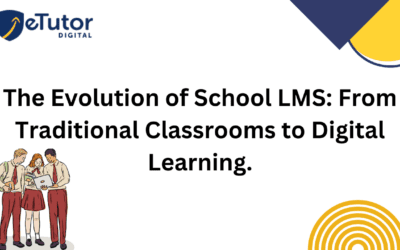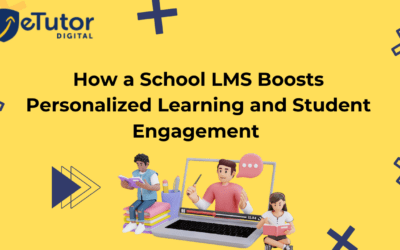How can your enterprise LMS help you identify and fill skills gap in your organisation?

Table of Contents
ToggleIntroduction
Educational institutions are confronted with a significant challenge, as a report from the World Economic Forum indicates that 44% of students’ skills may become outdated between 2023 and 2027.
The rapid evolution of technology is surpassing the ability of schools to adapt, leading to a surging demand for AI and big data skills, expected to grow by 60%. In light of this trend, it is anticipated that six out of ten students will require additional training by 2027.
Unfortunately, not all students have access to adequate training opportunities. This is where enterprise learning management systems (LMS), such as eTutor enterprise learning management systems, become invaluable in preparing educational institutions and their student body for the challenges of the future.
This blog post explores the key benefits of implementing enterprise LMS and how eTutor enterprise LMS can effectively bridge skill gaps in schools.
Key benefits of implementing enterprise LMS
The global enterprise LMS market is poised for substantial growth, with projections soaring from $8.1 billion in 2022 to an impressive $21.1 billion by 2027. This surge prompts a crucial question: What features should an enterprise LMS offer to optimize its value? Today, schools seek more than a basic training tool; they require a system capable of crafting interactive and personalized learning spaces to enhance employee productivity.
The rapid transition to online training during and post the COVID-19 pandemic has intensified this need, compelling schools to demand an LMS solution that is both adaptable and scalable.
A forward-thinking enterprise LMS should possess the capability to seamlessly integrate with various software tools, including diverse training modules.
This integration is pivotal for fostering a dynamic environment conducive to upskilling. By connecting effortlessly with different learning resources, the LMS ensures that employees can actively engage in continuous learning directly within the platform.
It encompasses the integration of external courses, granting learners convenient access to and completion of additional training modules without the need to navigate away from the centralized platform. The adaptability and scalability of such an LMS are crucial aspects, aligning with the evolving demands of schools seeking a comprehensive solution in the wake of the digital era.
Enterprise LMS provides a centralized platform for managing and delivering educational content. This hub streamlines the learning process by offering a one-stop destination for students, teachers, and administrators. This ensures easy access to resources, fostering a more efficient and organized learning environment.
One size doesn’t fit all in education. Enterprise LMS allows for the creation of customized learning paths tailored to individual student needs. This personalized approach ensures that students can progress at their own pace, addressing skill gaps and promoting a deeper understanding of the material.
eTutor enterprise LMS goes beyond traditional textbooks by offering a variety of interactive learning resources. From multimedia presentations to gamified quizzes, these engaging materials enhance the learning experience, making education more enjoyable and effective.
Monitoring student progress is essential for effective teaching. Enterprise LMS provides real-time analytics, allowing educators to track each student’s performance. This data-driven approach enables timely intervention to address skill gaps and provides valuable insights for continuous improvement.
Foster collaboration among students and educators through discussion forums, group projects, and interactive activities. Enterprise LMS facilitates a sense of community, encouraging knowledge sharing and peer-to-peer learning.
Bridging the skill gaps in your school with eTutor enterprise LMS
Now, let’s delve into how eTutor enterprise LMS can specifically address skill gaps in schools:
eTutor employs adaptive learning algorithms that identify areas where students may be struggling. The system then dynamically adjusts the learning path, providing additional resources and support where needed. This ensures that no student is left behind, and everyone has the opportunity to master essential skills.
eTutor’s enterprise LMS includes a robust feedback mechanism that allows teachers to provide personalized guidance to each student. Constructive feedback helps students understand their strengths and weaknesses, guiding them toward improvement.
eTutor offers a vast library of multimedia content, including videos, simulations, and interactive modules. This diverse range of resources caters to different learning styles, making it easier for students to grasp challenging concepts and bridge skill gaps.
Conclusion
In conclusion, the implementation of enterprise learning management systems, particularly eTutor, brings numerous benefits to schools. From providing a centralized learning hub to addressing skill gaps through adaptive learning paths, these platforms empower educators and students alike.
By embracing technology in education, schools can create an environment that fosters continuous learning, collaboration, and skill development, ensuring that every school increases their productivity and student reaches their evolving skill needs.
Recent Posts
- How School ERP Software Maximizes Productivity and Minimizes Cost
- How Does ERP Software for Schools Help Educators?
- Why Educational Institutions Need Online Exam Software in 2025
- How Is AI-Based ERP Software Transforming School Administration?
- Latest IIT-JEE & NEET Exam Trends 2025 | Key Changes in JEE, NEET 2025 Exams By NTA







